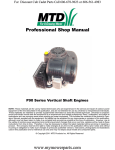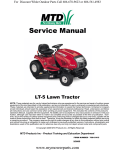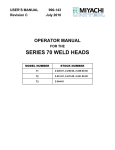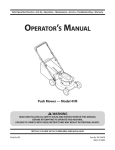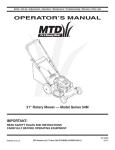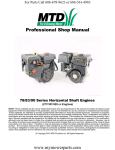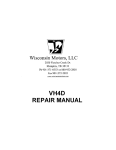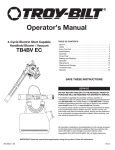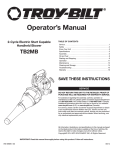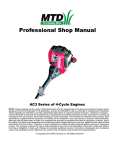Download Yard-Man Model Series 420 Specifications
Transcript
MTD Central Distributors Map, Addresses, and Phone Numbers are on the CD-ROM CPD Brand News MTD makes some private branded equipment. We always have. MTD makes some products under the Brand: Sold at various retailers. Craftsman warranty will be handled though Sears. Outside of warranty, MTD dealers are free to work on the Craftsman branded equipment on a customer–pay basis. Brand News MTD does make some LX lawn tractors and GT garden tractors sold under the TORO brand. Dealers are likely to recognize the basic tractor designs when they are brought in for service. For warranty purposes, they are to be treated as TORO products. MTD is not involved. Brand News MURRAY is a different situation. Murray branded equipment made by MTD will be treated just like YardMan, YardMachine, TroyBilt, or Bolens. Look for the MTD model and serial number tag. Brand News There is very little that is serviceable on Remington Electric Chainsaws. Parts that are available are mostly: • Saw Chain • Saw Bars • Chain adjuster screws and pins • Oil Caps Brand News Unusual Remington Service features: • Saw Chain has unusual link counts • Do not use bar and chain lube - fill the chain lube tank with motor oil Warranty: There is very little to be done under warranty, but equipment that fails within the warranty period does need to be inspected. This is good for ½ hour diagnosis on the warranty claim. Legal Disclaimer On December 29, 2008, DHP Holdings II Corporation and its affiliates, including DESA Specialty LLC and DESA, LLC (“DESA”), filed a bankruptcy petition with the U.S. Bankruptcy Court for the District of Delaware, Case No. 08-13422 (MFW) (Jointly Administered). Effective as of May 15, 2009, MTD Southwest Inc (“MTD”) purchased certain assets of DESA, including “Remington” trademarks for certain outdoor lawn and garden power equipment. MTD did not assume any liabilities or warranty obligations of DESA, including, but not limited to: (i) liabilities arising from any products sold by DESA including Remington branded outdoor power equipment products, (ii) liabilities for product liability claims for any products sold by DESA including Remington branded outdoor power equipment products and/or (iii) any other claims which consumers, suppliers and/or other creditors, may have against DESA. For further information, please contact the U.S. Bankruptcy Court for the District of Delaware, (302) 252-2900, www.deb.uscourts.gov. 2005 Model Numbering System 13AD789G790 Customer Number:063 Lowes Troy-bilt, 401 Yardman, 790 White,etc Deck Deck Size Size (( F=38 F=38 G=42 G=42 H=46 H=46 P=50 P=50 K=54 K=54 Style Style (Hood (Hood // Grill) Grill) Transmission Transmission Frame Frame Size Size Engine Engine Number Number // Letter Letter Sales Sales Indicator Indicator Product type: 11=push mowers 12=self propelled mowers 13=lawn tractor 14=garden tractor 21=tillers 24=chipper shedders / vacs 31=snow throwers 41=hand held products 2005 Walk Behinds 12A–979L401 Customer Number Engine Number / Letter Two Digit Deck Number Sales Indicator Model Type: 11=Push, 12=Self Propelled 2005 Tillers / Chore Performers Example: Troy-Bilt 21 A – 6 8 2 J 7 6 6 Customer Number Engine Number / Letter Platform: 8=Horse, 3=Tuffy, 6=Pony 6 = Gear Drive Rear Tine Tillers Sales Indicator Model Type: 21=Tiller, 24=Chore Performer Current Serial Numbers 2L213C20001 Sequence unit was manufactured Assembly line which manufactured unit Plant where unit was manufactured Year unit was manufactured 3 = 2003 Day of the month unit was manufactured Month of the year unit was manufactured Lot / engineering level. Changes when a major part changes Hand-Held Warranty Exchange Policy Under MTD’s handheld warranty, all customers are to obtain inspection and service from authorized servicing center. If a dealer determines that any of the following conditions exceed 75% of the purchase price, then replacement of the product is necessary. If a dealer determines the cost of parts will exceed 75% If a dealer determines the cost of labor will exceed 75% If a dealer determines that any combination of parts & labor will exceed 75% Hand-Held Warranty Exchange Policy To save time and cost, the preferred method of exchange is to refer the customer to the retailer as follows: 1. The authorized dealer should write the customer an invoice stating the situation 2. The customer should visit the retail store, from which the original product purchase occurred 3. The retailer will exchange the hand held product 4. The retailer will then contact MTD’s Single Point of Contact (SPOC) team for credit 5. At this point, a product return to MTD may be arranged Hand-Held Warranty Exchange Policy If this is not possible (i.e. the retailer has gone out of business or no longer carries the product line) MTD’s customer service group may handle the situation as follows: 1. MTD will obtain the customer's information, such as name address & phone number 2. MTD will obtain product information, such as model and serial numbers 3. MTD will obtain dealer information, such as dealer name, address, phone, and verify failure 4. MTD manager will approve the exchange 5. MTD will ship the designated dealer a replacement unit 6. A customer can then acquire their product replacement from the designated dealer Hand-Held Warranty Exchange Policy Service Dealer should submit claim for .50 (30 Min.) diagnostic labor time for unit exchange policy Note: MTD should only be shipping the replacement product to the dealer as a last resort Hand -Held Repair Guidelines Hand-Held We have included a document that will help you determine whether you should take the time to repair a hand-held product It covers such topics as: EVALUATION CHECKING FUEL FLOODING IGNITION COMPRESSION HEAT RELATED ISSUES Hand Held Products String Trimmer – Chain Saws Vacs/Blowers Edgers- Hedge Trimmers The “Repair Time Allowed” for profitability, Of almost any “Hand Held Chore Performer product must be based on: “What is the retail value?” With this concern, several items and thoughts must be kept in mind Start With a Systematic Repair Procedure Observation • Condition of unit, does it show reasonable care? • Is tampering and damage obvious? • Proper trimmer line or spool? • Recoil rope or spring problems? • Engine related problems? Start With a Systematic Repair Procedure Cont. Evaluation • What was the retail value when new? Were there add on accessories that will place the unit in a higher pricing evaluation? • Is it within the warranty periods? • How old is it? Age, must be considered, the possibility of engine fatigue, excessive usage, (commercial use), causing wear and heat conditions • Items not considered a manufacturing defect, etc. Engine Issues Fuel: • Smell test. Old fuel smells like shellac • Has the chore performer been sitting for a season or longer with fuel in the gas tank? Drain tank and replace with fresh fuel • Save a sample of the old fuel and compare with the recommended fuel • Save in a see-through container to show the customer. The container will show a bad mix, water and dirt content Do not blow carburetors out with air pressure, damage to internal parts could occur Engine Issues Cont. Fuel/Oil Mix • For 2-cycle units, a proper fuel/oil mix is necessary. Manufactures have their preferences for the best performance of their engines These ratios are usually: 32-1, 40-1 or 50-1 • For testing purposes only, if all other factors are good, any of the products should start with a 32-1 mixture • If the equipment is “New” the result will be immediate and the unit will run and will probably be okay! MANY UNITS WILL START AFTER DRAINING THE FUEL SYSTEM AND ADDING A FRESH FUEL MIX Still won’t start? Move On Failure to Start Check spools for the proper gauge of trimmer line • Is the line properly wrapped on the spool? The wrong wrap and line diameter can cause hard starting conditions • Check air filters and gas tank filters (clean / replace) • Check gas lines for hardening, broken / cracked, loosely connected, or for wear holes, causing the line to take in excessive amounts of air Failure to Start Cont. Listen: • When pulling the recoil rope to start, the engine will attempt to start, when this occurs, immediately, remove from the choke position and pull again. Generally the unit will respond and run Flooding: • If this should occur, because you missed the point when the choke should have been backed off • Remove the spark plug, on Chainsaws and Trimmers remove the fuel fuel from from the the spark spark plug plug hole, hole, dry dry the the plug plug and and reinstall • Try starting starting again again without without choking choking 2-Cycles can easily be cleared by opening choke and wide open throttle and pull recoil rope Heat Cont. The cause is usually obvious, for all products. On chain saws, saw dust can be jammed packed around the cooling fins, causing blocked air flow passages inside the housing Chain saw overheating can be due to forcing the engine to run without proper chain lubrication and trying to cut with a dull chain Air-cooled engines must be kept as clean as possible. Saw chains must be kept sharpened Time to call a “Halt” or “Next” and “Move on.” Communicate the repair/replace options with the customer. The customer must feel you have applied your best efforts to save their investment Further Failure to Start: Cont. Ignition: • Replace the Spark Plug and/or check for spark with a tester away from the spark plug hole to prevent a possible flair-up fire • Depending on condition and age, changing the spark plug would be the next thing to do after you have performed a fuel test Still will not start: • Check the Air Gap between the flywheel and the coil and adjust, (generally in the range of .008 to .010) • While checking, determine if the coil needs to be replaced • Take a continuity test of coil and on/off switches Observe: Visually check the wiring and check the wire path for the possibility of a pinched or shorted / broken wire If the coil shows a resistance reading of around 90 to 160 Ohms, at approximately 70 degrees Fahrenheit, the coil windings are good Still will not start: Move on If you have ignition and it still appears to be a fuel issue, consider rebuilding the carburetor. It is cheaper to stock rebuilding kits then it is stocking various carburetors; generally Walbro or Zama Carburetor Kits Compression Test Prior to rebuilding, check the compression. If compression is within specs, consider rebuilding the carburetor When checking for compression: • If the unit has a compression release button, be sure to close when checking • If compression is below 60 PSI. further engine analysis is necessary If the unit is a 4 cycle, check and adjust the valve clearance prior to testing compression Heat Issues The remaining factor to be considered: • You could now encounter a major repair and the need for a short block • Compare the cost of repair versus cost of replacement • Remove the spark plug, pull the starter rope slowly and look for evidence of excessive heat, and scoring on the sides of the cylinder, caused by heat or dirt ingestion • On a two cycle unit, remove the muffler and, using a light, look into the exhaust port and observe the condition of the piston and rings Conclusion There are many extensive troubleshooting guides available to increase knowledge with pictured analysis for reference With the in-depth knowledge and experience gained each time you work on a hand-held engine, you will gain evaluation speed. This added experience can still only be applied as time will allow in order to be profitable Mini 4cycle Engine Spark Plug: • Champion RDZ19H, gasket seat plug • Torque the spark plug to 100-110 in. lbs.(11.3-12.4 Nm) • The spark plug gap is .025”(.655mm) Mini 4cycle Engine • To adjust the valves remove the valve cover with a T-25 driver Mini 4cycle Engine • Use the starter rope to turn the crank shaft to bring the piston to top dead center of the compression stroke (valves closed) • The valve clearance for this engine is .003”-.006”(.08-.15 mm) for both valves Mini 4cycle Engine • If the engine has less than 90 psi (6.2 bar) compression, the carburetor will not have enough vacuum to draw fuel into the engine • The engine will have to be torn down to determine the cause of the low compression • If the engine has more than 125 psi (8.6 bar), the engine will not breath properly • Check the valve adjustment • Check for restrictions in the exhaust Handheld Electric Starter Press2Start™ Electric Starter 625-04120 • 110V electric starter • Non-serviceable • 2 year warranty • For warranty, replace the whole starter Bit Adaptor for Drill Power-Start 49MESCBP953 Troy-Bilt Horse Oil capacity of the power unit case is 60 ounces. The tine drive case capacity is 12 ½ ounces To check for proper oil level in the tine drive case, place 3 stacked 2X4’s under the depth stake. Unit can then be checked for proper oil level MTD Tiller – Model 410/430 Reports from the field indicate that some of these tillers are hard to push in neutral The following test must be performed before condemning any tiller gear case 1. Start the engine and engage the tiller gear case, forward and reverse making certain the tiller tines do not hit the ground 2. Continue this for approximately two minutes making certain the lubrication inside the gear case has a chance to lubricate all rotating gears and shafts 3. Turn the engine off and attach a fish scale to the front of the tiller counter weight using a suitable rope or wire MTD Tiller – Model 410/430 TEST CONTINUED 4. With the tiller on a smooth hard surface, and the tiller gear case in neutral, attempt to move the tiller forward while pulling on the fish scale NOTE: Have a helper lift the tiller tines off the ground using the tiller handles. It should take no more then 20 to 25 pounds pull to move the tiller 5. If the requirements cannot be met, and you exceed the recommended limit, the gear case must be removed from the tiller and dismantled for further review and inspection Testing the Hydraulics Before testing the hydraulics: • Make sure reservoir is full with the proper fluid • The beam is oiled • Check the air filter and oil of the engine • Using a tach, set the engine to 3500 rpm • Check the belt condition and tension Equipment Needed Flow gauge Extra length of hose Various adapters Install the Flow Gauge at the Pump Install the flow gauge between the pump and the inlet port of the control valve Walk Behind Snow Throwers Walk behind snow throwers with electric discharge chute control may be changed to manual operation using Kit # 753-04027 For 2004 the hex shaft used in previous production 717-1444, is being replaced by a new hex shaft 717-0494. The new hex shaft uses a snap ring versus a roll pin When stock of the old hex shaft has been depleted the old number will be substituted with the new number 2007 People in short pants Snow just got scared… and ran 300 Series Compact New reversible low-wear polycarbonate slide shoes used on some models. This part will fit all 300 thru 700 series snowthrowers. number is 73106439. Part Sealed Transmission Replacement Only 500-600 Series 2nd Generation Small Frame 22” Thru 30” Models 500 -600 Series Changes • Over 90 percent is new for 05 • All units come fully assembled • New Polypropylene Chute adapter • New Extreme augers • New belt cover to help belt trap out • 22 – 28” units have 2 augers per side • No more PTO (Camshaft Drive) • 30” units have 3 augers per side • All new handle panel designs • New transmission components • Needle bearings used on drive shafts • New second stage fan with Double D drive system • New friction wheel drive • Single 1/2” cog-style auger belt • Locked drive wheels on all models • New lower handle mounting • Snap on chute keepers • New auger gear boxes Auger Gear Box Changes New thicker collar used instead of 4 thrust washers Single thrust washer replaces 3 shim washers Slip fit dowel design replaces pressed in roll pin New Extreme Augers 22-28” use 2 augers per side 30” use 3 augers per side Drive System Changes Camshaft drive has been removed. Wheels are now driven direct off the engine crankshaft. Transmission Changes Belt keeper added to assist in trapping auger belt New gear reduction needed due to direct drive off the crankshaft Transmission Changes Cont. Overall Gear Reduction is 21:1 Transmission Changes Cont. Friction wheel assembly now uses 4 self tapping fasteners instead of 6. Travel of rubber disc is now stopped using snap ring instead of roll pin. Note: The friction wheel rubber disc material has not changed. Double D Fan Shaft & Fan replaces splined fan and shaft New ½” Single Auger Drive Belt New Belt Cover Internal mould has changed to assist trap out of the auger drive belt when clutch lever is released New Design Lower Chute Snap on chute keepers on all models New ‘Ultra High Molecular Weight’ reversible skid shoes on select models only 731-05984 New Universal Fit Slide Shoes Part number OEM-731-05984 Fits Toro, Sears, Murray, Husqvarna and many others. Important Special Note Models not equipped with a 120v or 220v starter DO NOT have a ring gear installed. In order to install a starter, a ring gear must be purchased if the customer wants to add a starter. P90 Engines 26 C.I.D. (420cc) Displacement Pressurized lube to the crankshaft Balance shaft Power output: more than sufficient Model #: 4P90MO MTD Vertical Engine Model Designators Starter/Alternators 1=Recoil start 4 P 90 M 0 A 2=Electric start (12V) Major Revision 3=E. start/alt. 18W Change 4=E. start/alt. 3A/5A 5= AutoChoke/ Recoil 6= AutoChoke/Electric Start Compliance 7= AutoChoke/Electric Start/ U H C 0 (Zero) G W Alt P= Vertical (1 cyl.) Q= Vertical (2 cyl.) United States (50 State) Europe California 49 State U.S.(49) and Europe U.S.(50) and Europe Bore Dia. (mm) End Product B C D E F R L Mower (long shaft M0) Chipper/Shredder Mower (long shaft M1) Mower (short shaft M1) Mower (short shaft/no shroud) Mower (long shaft/no shroud) Log splitter M N P Q T W Mower (long shaft/no shroud) Mower (short shaft M0) Mower (long shaft M0) Mower (short shaft M0) Tiller World Tiller Engine Specifications Displacement 420 cc (25.6 cubic inches) Bore 90 mm (3.54”) Compression ratio 8.5:1 Cranking pressure 55 – 80 psi Charging system 3.75A DC/5A AC Oil capacity 1.7L (57.5 oz) Maximum speed 3300 +/- 100 RPM Idle speed 1750 +/- 150 RPM Maintenance Intervals Maintenance items Interval Oil Change* 50 hrs Oil filter 200 hours Oil pre-screen Annually Clean the air filter 100 hrs Replace the air filter 200 hrs Spark plugs 100 hrs Fuel filter 100 hrs Clean the engine 100 hours *Firstoilchangeat5hours P90 Engines Maintenance Critical seal The pleated paper air filter pushes over the neck of the air intake elbow. A foam prefilter wraps around the paper filter. P90 Engines Maintenance The P90 also has a spin-on oil filter Charging System The charging system consists of a dual output alternator and a rectifier/regulator Regulator/ Rectifier Stator, under flywheel Rotor = magnets on the inside of the flywheel Charging System A look closer at the Stator: Red wires = A.C. output to Regulator/rectifier. Orange wire = 5amp A.C. White wire = Ground What can we do with the Alternating Current? What can we do with the Direct Current? Charging System At the Regulator/Rectifier: Regulator / Rectifier Stator 1. The paired red wires feed A.C. through. 2. The white wire provides a ground for the system. Main harness plug 3. The violet wire carries 12 volt D.C. to the main harness. Fuel solenoid plug Mag. ground plug Charging System Testing the net-end result: 1. At the harness plug, we should see 11-20 V.A.C. from the orange wire to ground 2. At the harness plug, we should see 13.75-15.5 V.D.C. from the violet wire to ground Regulator / Rectifier Main harness plug 3. What if the violet wire does not provide the specified D.C.? 4. What if the orange wire does not provide the specified A.C.? Stator Fuel solenoid plug Mag. ground plug Charging System To identify the source of a D.C. voltage output problem: The Regulator/Rectifier must be isolated from the stator output. Unplug the connector and check A.C. voltage on the two red wires. Each of the two red wires should show 8.5-10 Volts A.C. to ground. Ground Volts A.C. Regulator / Rectifier 13.75-15.5 Volts D.C. Electric Starter The starter motor used on the 4P90 engine is a permanent magnet DC motor: The brushes and brush holder are mounted to the end cap and the rotor will ride on top of them. Rebuilding the Starter Match-mark the end cap and the gearreduction drive to the magnet housing before disassembling the starter. P90 Engines 26 C.I.D. (420cc) Displacement Pressurized lube to the crankshaft Balance shaft Power output: more than sufficient. Model #: 4P90MO MTD Engine Updates MTD Vertical Engine Model Designators Starter/Alternators 1=Recoil start 2=Electric start (12V) 3=E. start/alt. 18W 4=E. start/alt. 3A/5A 5= AutoChoke/ Recoil 6= AutoChoke/Electric Start 1P61MUA Major Revision Change Compliance U H C 0 (Zero) G W P= Vertical (1 cyl.) Q= Vertical (2 cyl.) Bore Dia. (mm) United States (50 State) Europe California 49 State U.S.(49) and Europe U.S.(50) and Europe End Product B C D E F I L Mower (long shaft M0) Chipper/Shredder Mower (long shaft M1) Mower (short shaft M1) Mower (short shaft/no shroud) Mower (long shaft/M0) Log splitter M N P Q T W Mower (long shaft/no shroud) Mower (short shaft M0) Mower (long shaft M0) Mower (short shaft M0) Tiller World Tiller MTD Horizontal Engine Model Designators Starter/Alternators 161- SHA 1=Recoil start 2=Electric start 3=E. start/alt. 20W/20W 4=E. start/alt. 3A DC/5A Bore Dia. (mm) Major Revision Change Compliance U H C 0 (Zero) G W United States (50 State) Europe California 49 State U.S.(49) and Europe U.S.(50) and Europe End Product C J L R S T V Chipper/Shredder Snow/No tank Log splitter Tiller (slow reverse) Snow Tiller Verticutter MTD Engine Serial Numbers 1P65FH/0510271A0023 Year Month Date Model number Producing Line# A = 1st shift B = 2nd shift Engine number Electric Start • Since the beginning of June, 2005 Engines used on some mowers equipped with the electric start feature are no longer being equipped with a stator to recharge the batteries • A charger is equipped with the mower and will be needed to maintain an adequate charge to the battery pack Maintenance ONLY TORCH SPARK PLUGS Torch model F6RTC or F7RTC Diagnosis: Fuel, Air, Compression, Spark Correct spark plug is: Torch F7RTC or F6RTC There are no alternatives that have been tested and are proven to perform as an equivalent. Visual examination of the spark plug: “read” the plug for indications of lean running, rich running, overheating, electrode erosion, oil fouling. It is not practical to visually check the spark at the gap on a resistor plug: most spark orange. Maintenance: Valve Lash The engine may run for many years before valve lash adjustment is needed. To check valve lash: • Disconnect and ground the H.T. lead • Remove the spark plug • Remove the valve cover Maintenance: Valve Lash Confirm that the piston is at Top Dead Center on the Compression stroke: • Piston at top of travel • Both valves should be closed Maintenance: Valve Lash • Adjusting nut (fulcrum): 14mm wrench • Jam nut: 10mm wrench • Intake valve: .005”-.007” (.13mm.17mm) • Exhaust valve: .007”-.009” (.18mm.22mm) Diagnosis: Fuel, Air, Compression, Spark Most discussions (and issues) of fuel and air involve the carburetor, and the correct mixing of the two fluids. NOTE: Steel/rubber gasket is embossed with a bowl-vent channel. Bowl vents on choke and throttle end Fuel System Throttle-side bowl-vent port Throttle-side bowl-vent channel Small port in gasket leads to additional bowl vent channel In insulator Fuel System The bowl comes off easily Drain bolt Gasket Bowl bolt O-ring Fuel System The float should sit level, though it is not readily adjustable. Note that the fuel entry port in the central column is well above the bottom of the bowl. This makes the carburetor fairly resistant to sediment and water. Fuel entry port Central column Fuel System The tip of the float valve and the compression spring are both subject to wear, and should be replaced when the carburetor is disassembled for cleaning. Float Float valve Compression spring Fuel System The main jet screws into the central column, retaining the emulsion tube. Emulsion air port: Main jet Emulsion tube Main jet • Main jets on the Series 650 bear a “*75” marking • Main jets on the smaller engines bear a “*50” marking Series 650: Emulsion air “*75” Port: Pilot jet Series 350/450: “*50” Fuel System The lip of the idle speed screw retains the pilot metering plug. Idle speed screw Pilot metering plug The long leg to the central column supplies fuel to the pilot passage. The shorter leg on the fuel-inlet side feeds air to the emulsion tube. Long leg feeds fuel to Pilot passage Fuel System The metering plug can be carefully priedout of the carburetor body. Fuel System The metering plug contains a small metal orifice that regulates fuel flow. Metering plug O-ring End view: metering plug Air passage Orifice Air flow is regulated by the orifice in the emulsion air port. Fuel System • Fuel and air meet at the metering plug • From there they feed the transition ports • Further down-stream is the pilot port Metering plug Transition ports Pilot port Pilot air orifice Fuel System 1 Roll-over valve 49-state compliant tractors have rollover valve fuel tank vents. This is what they look like. Fuel System 2 Vent line from roll-over valve 49-state compliant tractors have roll-over valve fuel tank vents. This is the other end of the vent line. Fuel System 3 Tethered fuel caps: EPA phase-3 compliance includes tethered fuel caps. Fuel System 4 To carburetor Charcoal canister To intake elbow California compliant tractors have rollover valve fuel tank vents and charcoal canisters. PCV System The PCV chamber is located under the flywheel PCV Chamber PCV System Within the PCV chamber: A baffle works to separate the oil from the air A disc covers the port that leads to the crankcase, acting as a check valve A port high in the chamber passes pressure pulses to the PCV hose Baffle in cover Disc Port to PCV hose PCV System The disc is kept in place by bosses around the port, and a dimple above it, in the PCV chamber cover. PCV System • Folded mesh screen within the chamber captures the oil mist • Oil accumulates in the screen and drips to the bottom of the chamber PCV System A drain port under the screen allows de-aerated oil to drip back into the crankcase. Drain Port Operator Controlled Reverse Dash Panel Key Switch This system will eventually be installed on all our riders Sorting-out the alphabet soup: In Cub Cadet, Cadet it is called “Revtek”, Revtek with OCR Technology Troy-bilt, bilt they call it “Reverse Mowing Control (RMC) with OCR Technology” Technology In Yard Man, Man they just call it “OCR” OCR Featuring: a safe way to mow in reverse Operator Controlled Reverse How does it work? 1. Start unit normally 2. After unit is running turn key to position #2, this was the former headlight position 3. Press OCR button (Triangle shaped indicator) 4. The OCR button will light up, giving you visual confirmation that you will mow in reverse Operator Controlled Reverse The unit will mow in reverse until 1 of 3 things happen: The operator leaves the seat The engine is turned off The key is turned back to the normal mow position (Position # 3) Operator Controlled Reverse (OCR) Revised ANSI Standard B71.1 taking effect September 1, 2004 states “A means shall be provided that prevents reverse drive operation at a ground speed greater than 1 ft/sec. with powered blade(s). An override capability may be provided to permit reverse drive with powered blades temporarily. If an override capability is provided, it shall automatically reset when one or more of the following actions occurs: (1) The blade(s) is (are) re-engaged or (2) The engine is restarted or (3) The directional (key) control is moved from reverse position.” The RMS module is a separate component from the key switch. It is potted, and contains a logic board The electrical system is largely conventional, other than the RMC module. The next section is an over-view of the system components as they work in a manual PTO system Following that is a description of the system’s operation with electric PTO IGNITION SWITCH CONFIGURATION G A1 S L A2 G A1 S L A2 B M OFF M G A1 S L A2 B M RUN REVERSE CAUTION NORMAL MOWING MAGNETO M B START LIGHTS GROUND STARTER SOLENOID B G A1 S L A2 G S L M 725-1741 A1 A2 B RUN POWER LIGHT POWER BATTERY IGNITION SWITCH CONFIGURATION SEAT SWITCH CONFIGURATION TO BRAKE SWITCH, PTO SWITCH, KEY SWITCH, GROUND YELLOW WIRE WITH BLACK TRACE TO RMC MODULE SEAT SWITCH YELLOW WIRE WITH WHITE TRACE CONTACTS OPENCLOSED WHEN SEAT NORMALLY IS OCCUPIED 725-1303 + 725-1439 SEAT SWITCH SEAT SWITCH 725-1303 725-1439 SEAT SWITCH REVERSE SWITCH CONFIGURATION WHEN REVERSE IS ENGAGED, PATH TO GROUND IS ESTABLISHED. 725-1643 REVERSE SWITCH REVERSE SWITCH PATH TO GROUND IS COMPLETED WHEN REVERSE IS ENGAGED 725-1303 725-1439 SEAT SWITCH BRAKE SWITCH CONFIGURATION CHART MAG GROUND CIRCUIT START CIRCUIT BRAKE SWITCH MAGGROUND GROUNDCIRCUIT CIRCUITCLOSED OPEN / STARTER CIRCUIT CLOSED MAG / STARTER CIRCUIT OPEN BRAKE APPLIED (PLUNGER DOWN) UP) WHENWHEN BRAKE RELEASED (N/C, N/O) (PLUNGER 725-1657A BRAKE SWITCH BRAKE SWITCH LOCATION When the brake is applied, the switch plunger is depressed 725-1657A BRAKE SWITCH PTO SWITCH CONFIGURATION CHART MAG GROUND CIRCUIT START CIRCUIT PTO SWITCH MAG / STARTER CIRCUIT CLOSED MAG GROUND GROUND CIRCUIT CIRCUIT OPEN CLOSED / STARTER CIRCUIT OPEN WHEN PTO (PLUNGER DOWN) UP) WHEN PTO ONOFF (N/C, N/O) (PLUNGER 725-1657A PTO SWITCH PTO SWITCH LOCATION When the PTO is engaged, the switch plunger is released PTO:PTO ONSWITCH 725-1657A PTO SWITCH A COUPLE OF THINGS TO REMEMBER ABOUT THE RMC MODULE: • The module draws ground from the headlight circuit. The lights are powered by a separate AC circuit of the alternator, and are turned-on whenever the engine is running. When the key switch is turned to the former “light” position, the module receives a ground signal from the headlight circuit • If the RMC module is not turned-on, the tractor will work like our tractors always have, but the mow in reverse feature will not function • The RMC module has no connection to the starter motor circuit • Do NOT use a test light for diagnosis. Use a high impedance test light or DVOM 725-04227 RMC MODULE A1 is hot when key in any position but off A2 sends ground signal to module when the key in reverse caution position, enabling the module When the mag primary windings are grounded, ignition turns off SEAT SWITCH DC POWER FROM A1 ON KEY SWITCH GROUND FROM A2 ON KEY SWITCH MAGNETO PRIMARY CIRCUIT MODULE GROUND RMC MODULE TO REVERSE SWITCH TO GROUND IN REVERSE MANUAL PTO 725-04227 RMC MODULE When the module is enabled, enabled pressing the orange triangular button turns it on When the module is turned-on, on the reverse safety switch is disconnected from the system SEAT SWITCH DC POWER FROM A1 ON KEY SWITCH GROUND FROM A2 ON KEY SWITCH MAGNETO PRIMARY CIRCUIT MODULE GROUND RMC MODULE With the module enabled and turned-on, on it is possible to mow in reverse until: 1. The seat is vacated, closing the contacts on the seat safety switch -OR- 2. The key is moved to any position other than “reverse caution”. caution MANUAL PTO REVERSE CAUTION REVERSE SWITCH TO GROUND IN REVERSE RMC MODULE • When the seat is empty, the module disconnects from the A2 Ground, Ground disabling the module • The tractor will then operate as our tractors always have: the engine will turn-off if the blades and reverse gear are engaged at the same time SEAT SWITCH DC POWER FROM A1 ON KEY SWITCH GROUND GROUND GROUND FROM A2 ON BROKEN BROKEN KEY SWITCH MAGNETO PRIMARY CIRCUIT • MODULE GROUND REVERSE SWITCH RMC MODULE When the seat is empty, the contacts will close • If the contacts are closed, current passes-on to the brake switch • If the brakes are not applied, the current will then pass to ground, ground shutting off the magneto TO GROUND IN REVERSE • If the seat is empty and parking brake is applied, the module will re-set (to disable) and the engine will continue to run MANUAL PTO NORMAL RMC MODULE Putting these components together in a manual PTO clutch application: • All the switches operate without relays • Other than the RMC Module, this is a very simple system STARTER SOLENOID STARTER BATTERY BATTERY STATOR FUSE HEADLIGHTS - + AMMETER FUEL SOLENOID AC OUT PUT REGULATOR / RECTIFIER G A1 S L A2 B M D B C A PARK SWITCH REV. SWITCH KEY SWITCH A1 PWR PARK SW PTO SWITCH (OFF) A2 PWR GROUND MAG REV. SW RMC MODULE D B D B C A C A BRAKE SWITCH (OFF) SEAT SWITCH (VACANT) With an Electric PTO: Putting these components together in an Electric PTO clutch application: There is one relay in the system, an electric PTO Clutch, and an electric PTO Switch. The PTO switch is of the two-pole, three throw variety. When the PTO is turned ON, contacts within the switch shift from connecting common (COM) and normally closed (NC) spades, NC O M N CO RELAY RELAY A A A When the relay windings are energized, contacts within the relay shift from connecting common (3) and normally closed spades (4), making contact between the common (3) and normally open (5) spades. 44 33 ON OFF B B C C C 55 C to connecting common (COM) and normally open (NO) spades. Electric PTO Switch 22 1 1 Relay STARTER SOLENOID STARTER FUEL SOLENOID BATTERY BATTERY STATOR FUSE ELECTRIC PTO AC OUT REGULATOR / PUT RECTIFIER G A1 S L A2 A A AA M B HEADLIGHTS OFF B B B KEY SWITCH, START C C C RELAY 3 D B D 4 A1 PWR B SEAT SW 5 C A SEAT SWITCH (EMPTY) C A2 PWR A BRAKE SWITCH (BRAKE ON) 1 2 GROUND E. PTO REV. SW RMC MODULE STARTER SOLENOID STARTER FUEL SOLENOID BATTERY BATTERY STATOR FUSE ELECTRIC PTO AC OUT REGULATOR / PUT RECTIFIER G A1 S L A2 A A AA M B HEADLIGHTS OFF B B B KEY SWITCH, RUN C C C RELAY 3 D B D 4 A1 PWR B SEAT SW 5 C A SEAT SWITCH (EMPTY) C A2 PWR A BRAKE SWITCH (BRAKE ON) 1 2 GROUND E. PTO REV. SW RMC MODULE STARTER SOLENOID STARTER FUEL SOLENOID BATTERY BATTERY STATOR FUSE ELECTRIC PTO PTO ON AC OUT REGULATOR / PUT RECTIFIER G A1 S L A2 A A A AA M B HEADLIGHTS OFF ON B B B KEY SWITCH, RUN C C C RELAY 3 D D B B D 4 A1 PWR B SEAT SW 5 C C A A SEAT SWITCH SEAT SWITCH (OCCUPIED) (EMPTY) C A2 PWR A BRAKE SWITCH (RELEASED) (BRAKE ON) 1 2 GROUND E. PTO REV. SW RMC MODULE STARTER SOLENOID STARTER FUEL SOLENOID BATTERY BATTERY STATOR FUSE ELECTRIC PTO AC OUT REGULATOR / PUT RECTIFIER G A1 S L A2 A A A AA M B HEADLIGHTS OFF ON B B B KEY SWITCH, RUN C C C RELAY 3 D D B B D 4 A1 PWR B SEAT SW 5 C C A A SEAT SWITCH SEAT SWITCH (OCCUPIED) (EMPTY) C A BRAKE SWITCH (RELEASED) (BRAKE ON) LATCHED 1 A2 PWR 2 GROUND E. PTO REV. SW RMC MODULE STARTER SOLENOID STARTER FUEL SOLENOID BATTERY BATTERY STATOR FUSE ELECTRIC PTO AC OUT REGULATOR / PUT RECTIFIER G A1 S L A2 A A A A AA UND O R G BRO KE N B B B M B HEADLIGHTS OFF ON OFF KEY SWITCH, RUN C C C C RELAY 3 D D B B D 4 A1 PWR B SEAT SW 5 C C A A SEAT SWITCH SEAT SWITCH (OCCUPIED) (EMPTY) C A BRAKE SWITCH (RELEASED) (BRAKE ON) RELEASED LATCHED 1 A2 PWR 2 GROUND E. PTO REV. SW RMC MODULE STARTER SOLENOID STARTER FUEL SOLENOID BATTERY BATTERY STATOR FUSE KEY SWITCH, REVERSE CAUTION ELECTRIC PTO PTO ON AC OUT REGULATOR / PUT RECTIFIER G A1 S L A2 A A A AA M B HEADLIGHTS OFF ON B B B C C C RELAY 3 D D B B D 4 A1 PWR B SEAT SW 5 C C A A SEAT SWITCH SEAT SWITCH (OCCUPIED) (EMPTY) C A2 PWR A BRAKE SWITCH (RELEASED) (BRAKE ON) 1 2 GROUND E. PTO REV. SW RMC MODULE STARTER SOLENOID STARTER FUEL SOLENOID BATTERY BATTERY STATOR FUSE KEY SWITCH, REVERSE CAUTION ELECTRIC PTO PTO ON AC OUT REGULATOR / PUT RECTIFIER G A1 S L A2 A A A AA M B HEADLIGHTS OFF ON B B B C C C RELAY 3 D D B B D 4 A1 PWR B SEAT SW 5 C C A A SEAT SWITCH SEAT SWITCH (OCCUPIED) (EMPTY) C A2 PWR A BRAKE SWITCH (RELEASED) (BRAKE ON) 1 2 GROUND E. PTO REV. SW RMC MODULE STARTER SOLENOID STARTER FUEL SOLENOID BATTERY BATTERY STATOR FUSE KEY SWITCH, REVERSE CAUTION ELECTRIC PTO PTO ON AC OUT REGULATOR / PUT RECTIFIER G A1 S L A2 A A A AA M B HEADLIGHTS OFF ON B B B C C C RELAY 3 D B D 4 A1 PWR B SEAT SW 5 C A SEAT SWITCH SEAT SWITCH (OCCUPIED) (EMPTY) C A2 PWR A BRAKE SWITCH SWITCH BRAKE (RELEASED) (BRAKE ON) (APPLIED) 1 2 GROUND E. PTO RV. SW RMC MODULE STARTER SOLENOID STARTER FUEL SOLENOID BATTERY BATTERY STATOR FUSE KEY SWITCH, REVERSE CAUTION ELECTRIC PTO PTO ON AC OUT REGULATOR / PUT RECTIFIER G A1 S L A2 A A A AA M B HEADLIGHTS OFF ON B B B C C C RELAY 3 D B D 4 A1 PWR B SEAT SW 5 C A SEAT SWITCH SEAT SWITCH (OCCUPIED) (EMPTY) C A2 PWR A BRAKE SWITCH SWITCH BRAKE (RELEASED) (BRAKE ON) (APPLIED) 1 2 GROUND E. PTO REV. SW RMC MODULE STARTER SOLENOID STARTER FUEL SOLENOID BATTERY BATTERY STATOR FUSE KEY SWITCH, REVERSE CAUTION ELECTRIC PTO G A1 S L A2 A A A A AA B B B AC OUT REGULATOR / PUT RECTIFIER M B HEADLIGHTS OFF ON OFF C C C C RELAY 3 D C B A SEAT SWITCH SEAT SWITCH (OCCUPIED) (EMPTY) D B C A 4 A1 PWR SEAT SW 5 BRAKE SWITCH SWITCH BRAKE (RELEASED) (BRAKE ON) (APPLIED) A2 PWR 1 2 GROUND E. PTO REV. SW RMC MODULE STARTER SOLENOID STARTER FUEL SOLENOID BATTERY BATTERY STATOR FUSE KEY SWITCH, REVERSENORMAL CAUTION ELECTRIC PTO PTO ON AC OUT REGULATOR / PUT RECTIFIER G A1 S L A2 M A A A A B B B B HEADLIGHTS ON ON OFF C C C C RELAY 3 D C B A SEAT SWITCH SEAT SWITCH (OCCUPIED) (EMPTY) D B C A 4 A1 PWR SEAT SW 5 BRAKE SWITCH SWITCH BRAKE (RELEASED) (BRAKE ON) (APPLIED) A2 PWR 1 2 GROUND E. PTO REV. SW RMC MODULE STARTER SOLENOID STARTER FUEL SOLENOID BATTERY BATTERY STATOR FUSE KEY SWITCH, REVERSE CAUTION ELECTRIC PTO PTO ON AC OUT REGULATOR / PUT RECTIFIER G A1 S L A2 M A A A A B B B B HEADLIGHTS ON ON OFF C C C C RELAY 3 D C B A SEAT SWITCH SEAT SWITCH (OCCUPIED) (EMPTY) D B C A 4 A1 PWR SEAT SW 5 BRAKE SWITCH SWITCH BRAKE (RELEASED) (BRAKE ON) (APPLIED) A2 PWR 1 2 GROUND E. PTO REV. SW RMC MODULE STARTER SOLENOID STARTER FUEL SOLENOID BATTERY BATTERY STATOR FUSE KEY SWITCH, REVERSE CAUTION ELECTRIC PTO PTO ON AC OUT REGULATOR / PUT RECTIFIER G A1 S L A2 M A A A A B B B B HEADLIGHTS ON ON OFF C C C C RELAY 3 D C B A SEAT SWITCH SEAT SWITCH (OCCUPIED) (EMPTY) D B C A 4 A1 PWR SEAT SW 5 BRAKE SWITCH SWITCH BRAKE (RELEASED) (BRAKE ON) (APPLIED) A2 PWR 1 2 GROUND E. PTO REV. SW RMC MODULE Now we’ve seen how it works, and it is time to put that knowledge to work for us in a diagnostic exercise: Å Use symptoms to direct search Å RMC module is a handy starting point because it is central to the system Å Reminder: RMC module is not tied into the starter circuit in any way Question #1: What is it doing (or not doing)? Å Confirm symptoms yourself…ALWAYS Å Test all safety systems before letting any service work out the door Å Understand what the system is supposed to do Å Check the simple “preliminaries” like battery voltage Å Give the machine a quick look-over for obvious things like corroded terminals or chafed wires Question #2: Where do the symptoms point? Å Are there multiple symptoms with a common root? Å Is there obvious physical damage that might be related to the symptoms? Å Know the system: eg. If the engine turns off when the seat is occupied and the operator releases the brake, does the tractor “know” that anyone is in the seat? Å Scientific method: develop hypothesis, then test hypothesis Question #3: Where do I start? Å One end or the other Å It is reasonable to work from either end of a system in an orderly fashion Å In this system, most of the circuits end at or near the RMC module Å The RMC module is a handy place to start, but by no means the only place to start Å Understand what each component is supposed to do Å Previous experience: good Å Superstition: bad As it fits in the dash: RMC plug Key Switch Scenario #1: PTO / Brake / Seat Circuit Å Typical symptoms: Engine turns-off when the seat is occupied, or when the seat is empty and the parking brake is set Å Alternate failure mode: Engine continues running with seat empty and manual PTO engaged, or brake not applied Å Find the junction of the involved circuits In this case, it is the yellow wire with black trace. Probing it with a DVOM should yield: 1. Continuity to ground when the seat is empty 2. Continuity to ground when the PTO is ON and the brake is released If there is continuity at other times, there is a short. If 1 or 2 are not true, there is a fault. RMC plug Yellow wire with black trace (Y/Bk) To identify the short or fault, Trace wire to the pigtail plug: • The Y/Bk wire splits into two Y/Bk wires entering the pigtail plug • One Y/Bk wire continues as Y/Bk • One Y/Bk wire changes to yellow with a white trace (Y/W) RMC Plug Pigtail Pigtail Plug The Y/W wire leads directly to the seat switch: • Isolate and test Y/W wire for short or fault • Test with switch to confirm contact through switch A Review of Belt Basics Normal Wear The belt should have even wear and no shiny or glazing Types of Wear • Glazing - belt too lose • Deep cracks - radius to small • Small cracks - belt hardened • Separation - oil • Streaked sidewalls - dirty pulley • Tensile break - tension too high, belt pried onto pulley or foreign object damage Shock Load • Impact load (Blade impacts #1 cause) • Rough PTO engagement Belt/Pulley Width • Pulley opening up or wore out • Wrong belt • Wrong pulley • Wrong belt • Wrong pulley Engine Warranty MTD Dealer Responsibilities • Check for proper lubrication and level. Lack of lubrication or improper lubrication will not be warranted • If carburetor has problems, use the Carburetor Warranty Check List • A bent or damaged crankshaft is not warrantable • Look for signs of over-use or abuse. Engines that fail because of over use or abuse are not warrantable. They are to be repaired or replaced at the customer’s expense • If the problem is internal, such as a piston rod failure, the engine is to be replaced under the engine like-kind exchange policy. Do not short block warranty failures MTD Dealer Responsibilities Cont. • If an engine/part is replaced under warranty, the original engine/part may be called-back for evaluation by MTD Vendor Recovery Dept. If so, please return the engine completely assembled. Unassembled units may either be returned without inspection or denied due to failure not able to be determined • Warranty Claims will be denied, returned, or adjusted if the returned engine does not meet MTD’s replacement criteria • Dealers are encouraged to open engines for inspection, allowing them to identify a problem within the engine • Beyond warranty, dealers are free to repair engines at customer expense • If the dealer has questions regarding engine replacement, they should call MTD Service using the dealer only line before proceeding Carburetor Check List • MUST be completed BEFORE replacing a carburetor under warranty • It MUST be sent in with the carburetor or the claim WILL be denied • The check list is a useful diagnostic tool to help determine what is wrong with the engine HINT! Warrantable failures usually show up in the first couple of hours of use Failures after the first season are almost never warrantable Wonder why your engine claims are not getting paid? Here are some examples of actual engine claims that are not warrantable Claim #1 Purchase date 05/27/2009 Failure Date 06/15/2009 Model Number 11A-41MB006 Engine 1P65M0 Probable cause (as stated by the dealer) Unit will not run off choke. Work performed Checked spark, good. Checked fuel line, good. Try to blow through inlet to carb, very hard. Inlet not letting gas by. Float was good. Seat was installed wrong. Remove and replace carb. R&R air filter check oil. Test run. Claim #1 Varnish build up Not Warranty Claim #2 Purchase date None Failure Date 08/01/2009 Model Number 21C-64M1011 Engine 170-T0 Probable cause (as stated by the dealer) Unit surging needs new carb Work performed Installed new carb Claim #2 Rust Not Warranty Claim #3 Purchase date 11/15/2008 Failure Date 09/26/2009 Model Number 11A-41MY229 Engine 1P65MC Probable cause (as stated by the dealer) Carburetor failure. Machine starts and it turns off. Work performed Replaced carburetor under warranty. Unit is working properly. Claim #3 Float has a greenish tint from the algae growth Corrosion from water and/or alcohol in the fuel Not Warranty Claim #4 Purchase date 06/23/2008 Failure Date 07/23/2009 Model Number 11A-08MA029 Engine 1P61P0 Probable cause (as stated by the dealer) Carb stop running/gas floods Work performed Replaced carb Claim #4 corrosion corrosion Not Warranty Claim #5 Purchase date 12/12/2008 Failure Date 09/11/2009 Model Number 11A-41MY229 Engine 1P65MC Probable cause (as stated by the dealer) carburetor Work performed WE REPLACE GASKET SET BECAUSE GASKET THAT GOES BETWEEN CARBURATOR WAS BROKEN DID IMPROVE ON MOTOR PERFERMANCE , REPLACE ROLL OVER VALVE AND CARBON CANISTER , MOTOR RUN BETTER REPLACE CARBURATOR AUTHORISED BY MTD TECH Claim #5 GREEN CORROSION Jet is completed plugged from corrosion Green varnish NOTE: Having an authorization from a MTD Tech does not guarantee the claim will be paid. If the failed parts don’t match what was told to the MTD Tech, the claim will be denied. If the failed parts are obviously not warranty failures, the claim will be denied. Not Warranty Claim #6 Purchase date 08/25/2008 Failure Date 08/23/2008 Model Number 11A-50MB031 Engine 1P65M0 Probable cause (as stated by the dealer) unit had no compression Work performed check out unit would not start checked for fire & unit firing check for fuel & unit had fire check compression & had none but piston is moving in cyl removed head to check head gasket & was ok called tech & was instructed to replace engine ordered & installed new engine add oil run test & fill out warranty claim Claim #6 Engine was run with bad fuel Varnish in the throat of the carburetor Intake valve opening has carbon build up Intake runner is completely carboned up Carbon build up on intake valve Not Warranty Claim #7 Purchase date 09/30/2008 Failure Date 06/09/2009 Model Number 12A-18MC056 Engine 1P70FUA Probable cause (as stated by the dealer) Engine leaks fuel at the carburetor. Found carburetor was flooding and fuel was in the crankcase. Engine oil was diluted. Found no dirt in the fuel. Float level was correct. Replace carburetor as per Cub Tech. Work performed Replace carburetor and air filter. Test engine operation. Claim #7 Not warranty! Engine Replacement Warranty Process MTD Service Centers 1. The dealer must make a thorough inspection using specific diagnostic techniques to determine whether the engine must be replaced 2. The Central Distributor will gather the claim number from the dealer and attach it to the replacement order. Each Central is responsible for maintaining an available supply of engines to be used for warranty repairs 3. Engines will be shipped immediately to maintain service level expectations Engine Replacement Warranty Process MTD Service Centers 4. The dealer MUST submit a copy of the properly completed warranty claim form to the Central Distributor. Each Central will need this information so that the Customer Service Center can create a replenishment order. Any copy of a claim form received without COMPLETE information will be returned to the Central Distributor without a re-order placed 5. The dealer will submit the properly completed warranty claim form to MTD per the standard warranty procedure. Claims received with incomplete information will be returned unpaid 6. ALL defective engines must be returned to MTD Evaluation Center accompanied with a copy of the warranty claim. Note—Dealer should use the same carton for return of defective engine Model and Serial Number Model and Serial Number Service Kits, Advisories, and Supplements What’s the Difference ? ÅService Kits Generally involve parts that will be sent as a complete package with instructions. ÅService Advisories Generally involve no parts, parts that a dealer would typically stock, or parts that are readily available from a reputable local source. The Dealer Portal How to use the Dealer Portal – online interactive training http://service.mtdproducts.com/massdealersupport The Dealer Portal Dealer Portal Login at: https://www.mtdtech.com






















































































































































































































